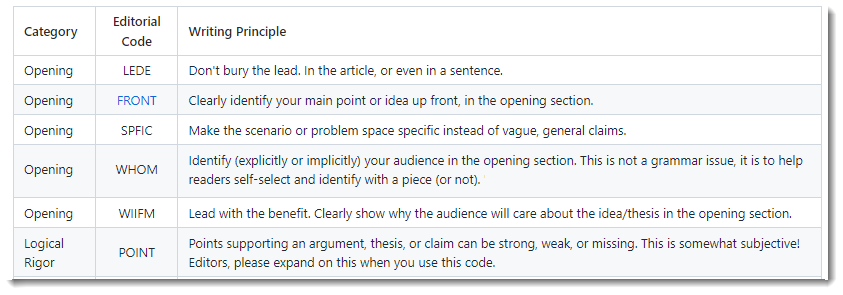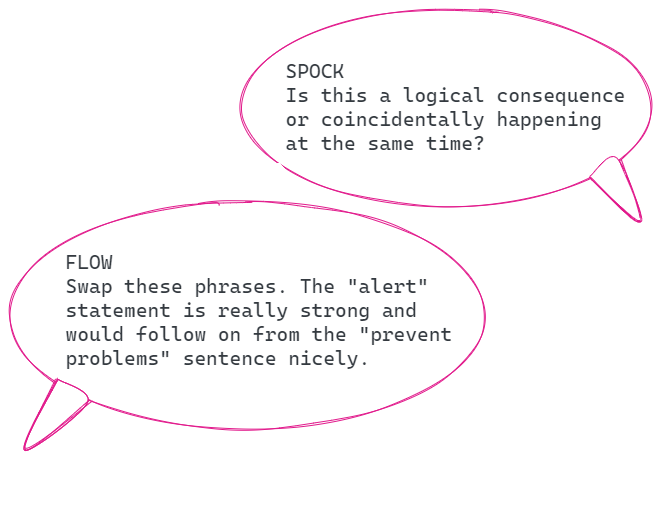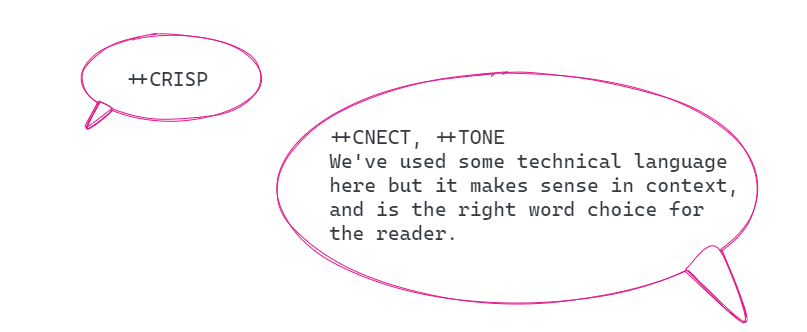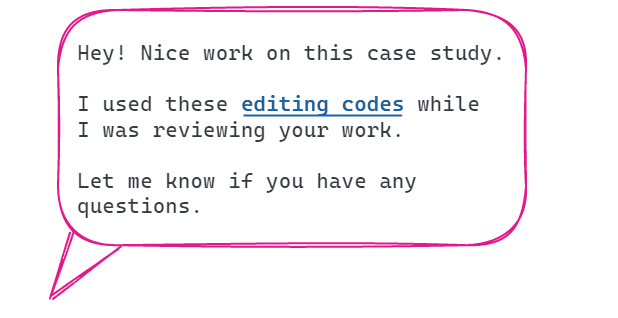You need to pack a lot of punch into your editing comments. They need to explain the what, why and what-next, all at once. It can be hard to fit all that in. 😤
Editing codes to the rescue! 🦸♀️ Using a code rolls up the ‘why’ to leave you space for your feedback and suggestions.
What they are
Editing codes are semantic short codes that represent the writing principles in your writer’s guide.
The codes are a lightweight convention for reviewing content. They communicate the rationale behind a suggested edit based on a specific writing guideline.

Why they’re good
Keep it neutral
Edit the writing, not the writer. Codes depersonalize feedback - removing emotion, subjectivity, and any heat from a comment. By linking back to an external, authoritative source, there is less chance of error, confusion, or offense.
“By simply prefixing the comment with a label, the intention is clear and the tone dramatically changes.”—Conventional Comments
Abstract the detail
Editing shouldn’t be a black box. It’s valuable to the writer when the edit is explained. But you don’t have the time (or space) to explain the ‘why’ for every writing principle. Rolling up a writing guideline into a short code is a handy space-saver, and it’s got traceability to the style guide.
“EXPLAIN WHY. If I’m editing someone’s content, I take time to explain why I’ve made a particular edit.” —Ingrid Towey (Editing principle #4)
Reinforce good habits
Praise is essential to show what a writer did well so that they continue their good habits. Ingrid Towey explains that “You don’t want writers to stop doing the thing they’re doing correctly because nobody ever commented on it.”
The editing codes can be used to praise as well as suggest improvement. Praise is beneficial when it’s specific - and the codes let you get really detailed and explicit with your praise.
“Praise something specific”—PIPS method of feedback from Toastmasters.
Encourage mindful editing
Don’t rely on your instincts when you’re editing. The codes help you push past the innate gut feeling to dig into the why. Having to assign a code to your feedback compels you to articulate why you’re suggesting a change and explain the rationale behind your edit.
Using codes means that writers can expect a systematic, consistent editing experience. No nasty surprises!
How to use them
When you make an edit, preface your feedback with the code. This does, initially, add overhead to your process. You’re forced to slow down to find the appropriate code for your edit. But it’s this process of pinpointing your feedback that will make you a better, more mindful editor.
Constructive feedback: Use a code, then give your comment or suggestion. No need to explain context - the code encapsulates the writing principle that underpins your feedback.

Giving praise: Add a ++ to the code to signify praise. You can follow with extra detail or just let it stand alone.

Tell your writer: Add a comment at the start of your review to let your writer know that you’ve used the edit codes - and provide a link to the list so they can find them easily.

Try them today
Interested? Check them out, read about how we use them or listen to me and my colleagues talk about them on the OSP podcast.
Let me know if you think of any other cool use cases for using the codes!
Image credits: Clockwork gears photo by Laura Ockel on Unsplash



